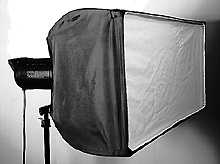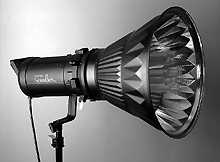
To overcome this problem, a high frequency - like 1kHz or 1,000 cycles per second - is needed at the very least. Better results, not prone to any interference 'beat', are obtained with extremely high frequency lights.
The Scandles fluorescent light-heads for video and digital cameras use a 39kHz ballast - that’s 39,000 cycles per second - to ensure compatibility with every form of CCD based cameras. They use Philips 95 tubes with a spectrum limited to spikes which are claimed to coincide well with the red, green and blue sensitivity of CCD arrays without including unwanted infra-red.
The six tubes are of the U-shaped double type, mounted sticking forward from the head which resembles a monobloc flash body. They have a total light output per head of 10,000 lumens at 5,300K, equal to a 2000W ‘blonde’ tungsten head with 80A A-to-D filter, yet at 150W use only 1 amp per head and create almost no heat. The tubes have a 15,000 hour life and are extremely consistent in output, needing a few minutes only to warm up.
Each head has only two forms of control - on/off switch, and three switches which control the tubes in opposed pairs. We thus have full power, 2/3rds, and 1/3rd available from each head.

The Scandles rectangular soft box
The reflector mounting ring of the Scandles head is compatible with Chimera, Worldbank, Wafer and Photoflex soft boxes. Not all will fit, because the tubes stick forward, and only specially designed reflectors are truly efficient. The currently available designs include a small rectangular light bank with removable front diffusor, a deep 'sports' reflector which acts like a parabolic, and a close-up subject sideways reflector with controllable aperture. Umbrellas do not make an efficient reflector for Scandles.

The Scandles head, showing the tubes visible at the front of the Sports Reflector, which is a very unusual deep conical design
In use, we found the level of light from a single head inadequate for the Leaf Lumina at smaller apertures. Two heads were fine for flat art copies. An ideal kit needs three heads, with two light banks and two sports reflectors. The light is very easy to work with but rather general in effect due to the large source area, and visually high-coloured.
This colour balance was not ideal for the Leaf Lumina. A typical neutral-card reading was R 17 msec, G 11 msec, B 19 msec. The blue time is expected to be longer than the other two, but the 50 per cent excess green present in the Scandles light was not welcome. A magenta warm-up filter pack is needed to balance the exposure levels for full control, even though the software will produce a neutral result without this.
Designed by American Gary Regester and manufactured in Britain by Systems Imaging Ltd, Scandles are distributed in the UK by George Elliott & Sons Ltd and available through other lighting specialists like Photon Beard Ltd.
The cost per head - under £600 GB pounds plus VAT - is high compared to studio flash or tungsten, but low when considered as an alternative to the other main flicker-free light source, the costly and difficult to use HMI.
Scandles are finding widespread use in small video and TV studios where the cool running makes life comfortable for talking head shots. As yet, the digital imaging market is very much smaller, but is expected to grow. New reflectors and accessories are anticipated, and buying into the system - which is also excellent for studio still life on conventional film - would not seem to be courting obsolescence, as is often the case with demand-driven new technologies.
The only problem we have had with Scandles has been that of accurate initial assembly - the method for securing the tube array is not well designed, and requires tools which don’t exist as well as elves' fingers instead of the human sort. A protective clear cover for the vulnerable glass tubes is now being added to the specification to comply with safety at work requirements; there is already a metal shield tube for use when transporting them on location.